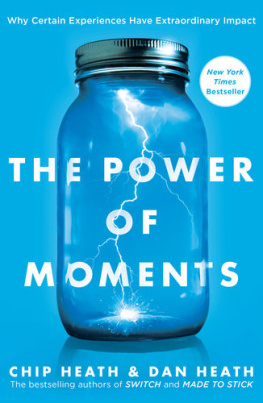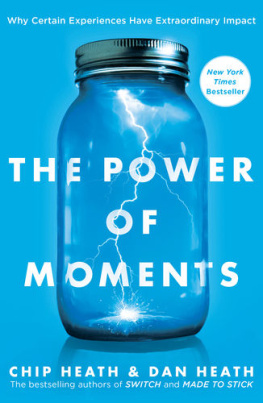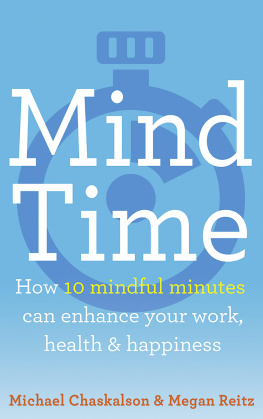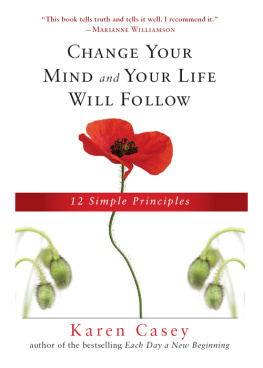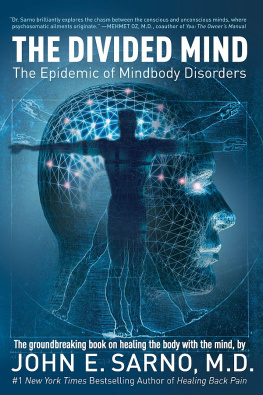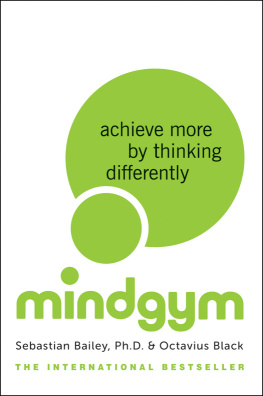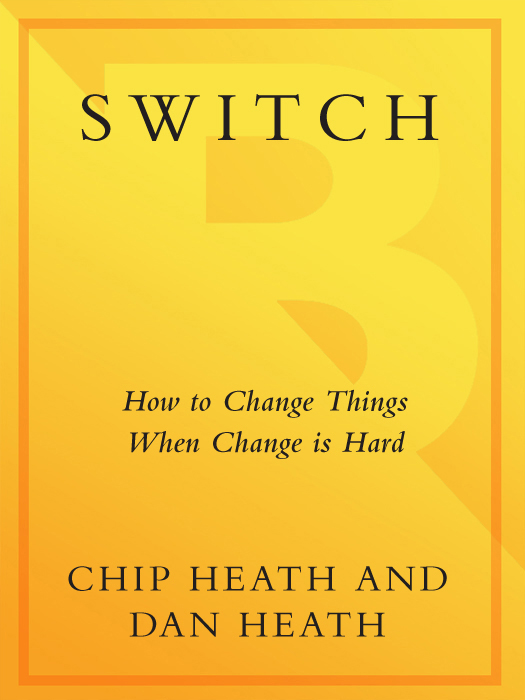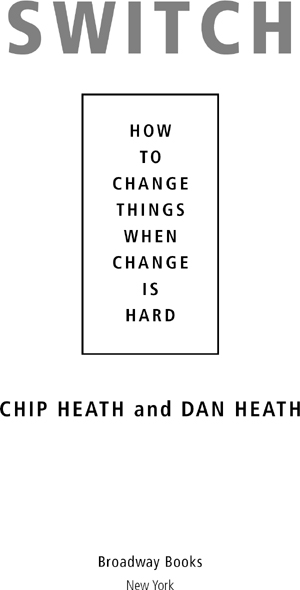To our wives,
Susan and Amanda,
who changed everything
Contents
1
Three Surprises About Change
1.
One Saturday in 2000, some unsuspecting moviegoers showed up at a suburban theater in Chicago to catch a 1:05 p.m. matinee of Mel Gibsons action flick Payback. They were handed a soft drink and a free bucket of popcorn and were asked to stick around after the movie to answer a few questions about the concession stand. These movie fans were unwitting participants in a study of irrational eating behavior.
There was something unusual about the popcorn they received. It was wretched. In fact, it had been carefully engineered to be wretched. It had been popped five days earlier and was so stale that it squeaked when you ate it. One moviegoer later compared it to Styrofoam packing peanuts, and two others, forgetting that theyd received the popcorn for free, demanded their money back.
Some of them got their free popcorn in a medium-size bucket, and others got a large bucketthe sort of huge tub that looks like it might once have been an above-ground swimming pool. Every person got a bucket so thered be no need to share. The researchers responsible for the study were interested in a simple question: Would the people with bigger buckets eat more?
Both buckets were so big that none of the moviegoers could finish their individual portions. So the actual research question was a bit more specific: Would somebody with a larger inexhaustible supply of popcorn eat more than someone with a smaller inexhaustible supply?
The sneaky researchers weighed the buckets before and after the movie, so they were able to measure precisely how much popcorn each person ate. The results were stunning: People with the large buckets ate 53 percent more popcorn than people with the medium size. Thats the equivalent of 173 more calories and approximately 21 extra hand-dips into the bucket.
Brian Wansink, the author of the study, runs the Food and Brand Lab at Cornell University, and he described the results in his book Mindless Eating: Weve run other popcorn studies, and the results were always the same, however we tweaked the details. It didnt matter if our moviegoers were in Pennsylvania, Illinois, or Iowa, and it didnt matter what kind of movie was showing; all of our popcorn studies led to the same conclusion. People eat more when you give them a bigger container. Period.
No other theory explains the behavior. These people werent eating for pleasure. (The popcorn was so stale it squeaked!) They werent driven by a desire to finish their portion. (Both buckets were too big to finish.) It didnt matter whether they were hungry or full. The equation is unyielding: Bigger container = more eating.
Best of all, people refused to believe the results. After the movie, the researchers told the moviegoers about the two bucket sizes and the findings of their past research. The researchers asked, Do you think you ate more because of the larger size? The majority scoffed at the idea, saying, Things like that dont trick me, or, Im pretty good at knowing when Im full. Whoops.
2.
Imagine that someone showed you the data from the popcorn-eating study but didnt mention the bucket sizes. On your data summary, you could quickly scan the results and see how much popcorn different people atesome people ate a little, some ate a lot, and some seemed to be testing the physical limits of the human stomach. Armed with a data set like that, you would find it easy to jump to conclusions. Some people are Reasonable Snackers, and others are Big Gluttons.
A public-health expert, studying that data alongside you, would likely get very worried about the Gluttons. We need to motivate these people to adopt healthier snacking behaviors! Lets find ways to show them the health hazards of eating so much!
But wait a second. If you want people to eat less popcorn, the solution is pretty simple: Give them smaller buckets. You dont have to worry about their knowledge or their attitudes.
You can see how easy it would be to turn an easy change problem (shrinking peoples buckets) into a hard change problem (convincing people to think differently). And thats the first surprise about change: What looks like a people problem is often a situation problem.
3.
This is a book to help you change things. We consider change at every levelindividual, organizational, and societal. Maybe you want to help your brother beat his gambling addiction. Maybe you need your team at work to act more frugally because of market conditions. Maybe you wish more of your neighbors would bike to work.
Usually these topics are treated separatelythere is change management advice for executives and self-help advice for individuals and change the world advice for activists. Thats a shame, because all change efforts have something in common: For anything to change, someone has to start acting differently. Your brother has got to stay out of the casino; your employees have got to start booking coach fares. Ultimately, all change efforts boil down to the same mission: Can you get people to start behaving in a new way?
We know what youre thinkingpeople resist change. But its not quite that easy. Babies are born every day to parents who, inexplicably, welcome the change. Think about the sheer magnitude of that change! Would anyone agree to work for a boss whod wake you up twice a night, screaming, for trivial administrative duties? (And what if, every time you wore a new piece of clothing, the boss spit up on it?) Yet people dont resist this massive changethey volunteer for it.
In our lives, we embrace lots of big changesnot only babies, but marriages and new homes and new technologies and new job duties. Meanwhile, other behaviors are maddeningly intractable. Smokers keep smoking and kids grow fatter and your husband cant ever seem to get his dirty shirts into a hamper.
So there are hard changes and easy changes. What distinguishes one from the other? In this book, we argue that successful changes share a common pattern. They require the leader of the change to do three things at once. Weve already mentioned one of those three things: To change someones behavior, youve got to change that persons situation.
The situation isnt the whole game, of course. You can send an alcoholic to rehab, where the new environment will help him go dry. But what happens when he leaves and loses that influence? You might see a boost in productivity from your sales reps when the sales manager shadows them, but what happens afterward when the situation returns to normal? For individuals behavior to change, youve got to influence not only their environment but their hearts and minds.
The problem is this: Often the heart and mind disagree. Fervently.
4.
Consider the Clocky, an alarm clock invented by an MIT student, Gauri Nanda. Its no ordinary alarm clockit has wheels. You set it at night, and in the morning when the alarm goes off, it rolls off your nightstand and scurries around the room, forcing you to chase it down. Picture the scene: Youre crawling around the bedroom in your underwear, stalking and cursing a runaway clock.
Clocky ensures that you wont snooze-button your way to disaster. And apparently thats a common fear, since about 35,000 units were purchased, at $50 each, in Clockys first two years on the market (despite minimal marketing).


